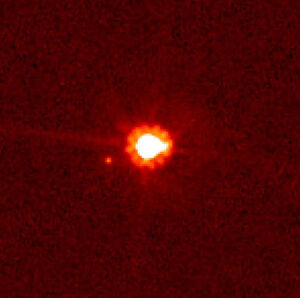Eris is a dwarf planet located in the Kuiper Belt. By mass, it is the most massive Kuiper Belt Object (KBO), but it is the second massive by diameter after Pluto. The discovery of Eris dethroned Pluto from its rank of the 9th planet.
Characteristics[]
Eris has an elliptical orbit, with distance to the Sun varying from 37.9 to 97.7 AU. It orbits around the Sun in 558 Earth years. Its diameter is 2326 km and its average density is 2.52. It appears that Eris lacks an atmosphere. Its surface is highly reflective and spectroscopic analysis show the presence of methane ice.
The rotation period is unknown. Eris shows no variations in brightness, which suggests its rotation axis might be tilted and one pole is currently set towards the inner Solar System. Also, it is possible that the whole planet is covered with a layer of methane, giving it an homogenous color.
Currently, Eris is close to its aphelion (highest distance to the Sun) and all its atmosphere is frozen. However, at perihelion, it is possible that a significant amount of methane sublimates into he atmosphere. In contact with ultraviolet light, X rays and cosmic rays, methane is transformed into acetylene and other chemical compounds, which then merge into tholins. The fact that we don't see tholins on the surface of Eris means that methane ice that we see now was recently made.
Giving its size, it is highly possible that Eris is a differentiated object. If so, it has a rocky core, far larger then Pluto, surrounded by a subsurface ocean and a thick icy crust. Under the methane ice, there must be tholins and other organic compounds. Having a larger core then Pluto, Eris can produce more energy via nuclear fission, keeping its ocean liquid for longer. However, an even larger celestial body, Callisto, is not differentiated. If Eris is not differentiated, then it must be made of a mixture of water ice, frozen gasses and rocks.
No surface details are known for Eris.
Eris orbits very far from the Sun. Its Solar Constant is very low, making plants life hard (see Plants on new worlds for details).
It could be possible, using huge amounts of greenhouse gasses, to keep a suitable temperature on Eris for humans to live. However, given its highly eccentric orbit, at perihelion temperatures might reach water boiling point, while at aphelion, water will freeze on the whole planet.
Human Interaction[]
Eris will at first be visited by a few unmanned probes. Then, at some point, it will be targeted by manned ships and even by pioneers who will want to build their homes on this remote world. Depending on many conditions, Eris, might be a target for Basic Colonization, for Industrial colonization, for Paraterraforming or even for complex Terraforming.
Basic Colonization does not imply radical transformations on the planet. At first, a research station will be built. Then, colonies will form on the surface or underground, without affecting large areas of the surface. Inside each town, there will be buildings with good thermal insulation and with enclosed ecosystems. Vehicles will travel on the icy surface or underground.
Industrial colonization will be possible if there is something that can attract investors. Like Pluto, Eris must contain high amounts of tholins and other organics. In a world that has long exhausted its fossil fuel deposits, organic compounds are essential for plastic and rubber, which can be found in every part of our daily life. If that is the case, on the surface of Eris we will see many industrial centers. Also, Eris's moon, Dysmonia, will become a space station that will allow large ships to dock. Towns will grow around each industrial center. The environment will be affected and heat produced by human activities will force some atmosphere to form.
Internal paraterraforming is also possible for Eris. Under a protective layer of water ice, enclosed greenhouses and large cities can be formed. They will be protected from the cosmic void, from cosmic rays and from meteorites. Since the Sun is too far away for plants to undergo photosynthesis, the lack of natural light is not a major concern.
Classic paraterraforming is possible for limited or large areas. Under domes and shields of glass, plants, animals and humans can grow. However, we will need an additional source of heat and of light, to make life possible. Also, the surface, which is made of water ice and volatiles, will evaporate or melt, affecting anything built on it. Ground Insulation is mandatory.
Terraforming is possible at high costs, but the planet will always require human intervention. First step is to build an oxygen-rich atmosphere, which can be created by artificial means. Plants will barely survive at this low luminosity. Then, the icy ground must be covered with something to prevent it from heating (see Ground Insulation), then covered with a layer of rocky materials.
Eris then will receive a significant amount of greenhouse gasses, but not enough. The Sun will provide only limited amount of the light and heat needed. An Artificial sun is needed. For this purpose, we can use a large nuclear plant on the moon Dysmonia or build power plants into orbit. At perihelion, the Sun will provide most of the heat and light, while at aphelion, most of the energy will come from artificial sources.
Conclusion[]
The terraforming of Eris is one of the most expensive in the Solar System and will require a continuous input of energy. However, this will provide humanity with a second outpost in the Kuiper Belt after Pluto.
There are many rogue planets free-floating in interstellar space. Terraforming Eris will be a test before we can go beyond the borders of the Solar System.
See also: Eris Simulation.
